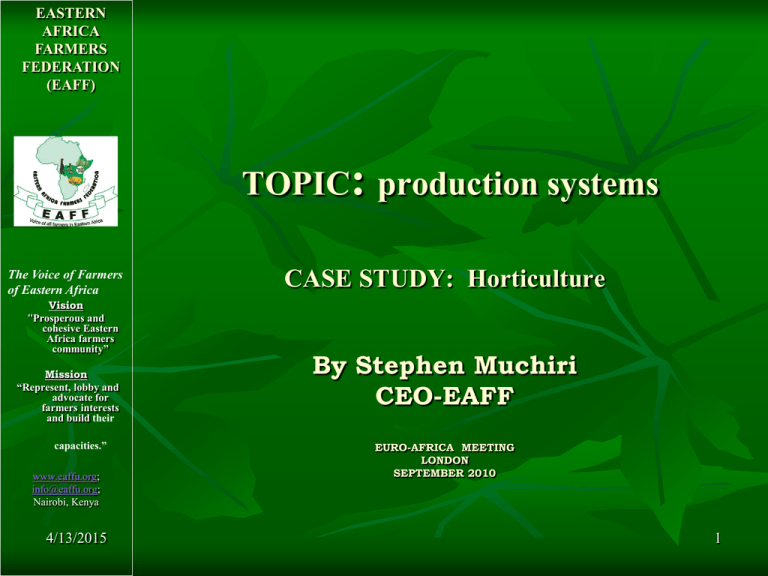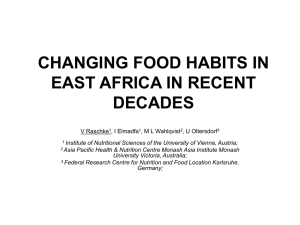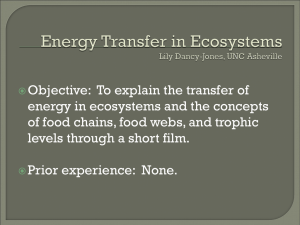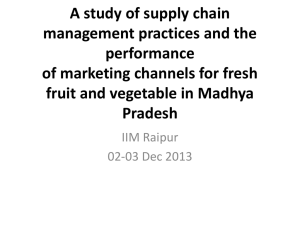kenya national federation of agricultural producers
advertisement

EASTERN AFRICA FARMERS FEDERATION (EAFF) TOPIC: production systems The Voice of Farmers of Eastern Africa Vision ''Prosperous and cohesive Eastern Africa farmers community” Mission “Represent, lobby and advocate for farmers interests and build their capacities.” www.eaffu.org; info@eaffu.org; Nairobi, Kenya 4/13/2015 CASE STUDY: Horticulture By Stephen Muchiri CEO-EAFF EURO-AFRICA MEETING LONDON SEPTEMBER 2010 1 Outline 1. Introduction 2. Local food webs 3. Processes disrupting local food webs 4. Measures processes & technologies affecting food sovereignty 5. Actions, processes and research to improve food sovereignty 4/13/2015 2 1) Introduction Since 1985 horticultural produce and commodities have been experiencing increasing importance in developing countries, especially fruits and vegetables making up a large proportion of their exports. Future growth will likely depend on rising and changes in demand in both developed and developing countries and on the capability of emerging economies to maintain or increase their competitive strength in world markets. Agricultural productivity in most sub-Saharan countries is 2-3 times lower than the world average and the production gap between developing and developed countries is widening. Horticulture commodities are predominantly produced by small (<1 acre) to medium scale farmers (10 acres) in sub-Saharan Africa (SSA) where only 10% of the land is considered arable. For example, smallholder farmers in Kenya generate 40 to 50% of total exports and 90% of the commodities consumed locally 4/13/2015 3 Introduction Major constraints facing horticulture smallholder farmers include: high inputs costs, insecurity, poor storage, farm and road infrastructure, inadequate extension support services, limited awareness on market access or market standards, limited farmer institutions/centres for specific training and information channeling related to horticulture hence minimal capacity building particularly in production. Those smallholder farmers producing for export face additional challenges such as: inaccurate trade data, limited compliance to regulatory standards i.e. good agricultural practices or trade standards, TBTs like “food miles” and increasing freight charges 4/13/2015 4 2) local food webs Vegetable production constitutes a key component of the livelihood strategy for poor farmers, providing revenues and jobs in developing countries while improving general nutrition. Root vegetables are staple foods in many African countries. Although some African city dwellers produce food, both for their own consumption and commercial sale, most purchase their food. This urban market is much more accessible than export markets to rural and peri-urban producers. In most cases, especially non-processed food, domestic producers can compete with imported products. Urban dwellers do not follow the same consumption diet as their rural counterparts, preferring greater amounts of meat, dairy, oils and fats, and fruit and vegetables such as tomatoes and potatoes, and they increasingly demand a yearround supply of these items. Rural producers need to first understand what is in demand, then how to supply it year round. This applies to intermediate goods as well—for example, greater demand for meat and dairy will also imply a greater demand for grains as feed for animals. 4/13/2015 5 local food webs Fruit and vegetables account for about one-sixth of the value of EU agricultural production. The EU is the second largest producer in the world, the second largest exporter and the largest importer of fruit and vegetables. In line with the earlier EU Common Agricultural Policy (CAP), price support was a major feature of the EU fruit and vegetable regime, implemented largely through the establishment of a minimum grower price for specific products falling under the fruit and vegetable regime. This gave rise to an associated entry price system (operating on the basis of minimum import prices) to regulate trade in fruit and vegetables. However, CAP reforms in 1996, 2001 and 2007 saw the abandonment of price support in favour of increased levels of direct aid to farmers. The incorporation of the fruit and vegetable sector into the single payment scheme was in line with the wider development of the CAP. Within this process of reform, increasing emphasis has been placed on support to producer organizations. 4/13/2015 6 local food webs Despite these reforms, the EU, according USDA, continues to operate an external trade regime for fruit and vegetables regulated through a complex system of import quotas, seasonal restrictions and preferential trade arrangements, guided by the entry price system. For processed products, additional duties are charged based on the sugar content of the product, except for the ACP/LDC group (countries both in the ACP and least developed countries), where full duty-free, quota-free access for sugar is now enjoyed. About 37 ACP countries are involved in exporting fruit and vegetables to the EU, accounting for less than 10% of EU imports. The reform process in the fruit and vegetable sector has, by lowering EU producer prices, reduced the attractiveness of the EU market for undifferentiated fruit and vegetable exports from the ACP. In the case of the ACP, the challenge faced is compounded by increased competition from third-country suppliers, as the EU concludes a growing range of bilateral preferential trade arrangements with competitive suppliers in the fruit and vegetable sector, and the stricter enforcement of food safety standards and the growing role of private voluntary standards in determining access to certain 4/13/2015 components of the EU market. 7 local food webs Against this background, ACP horticultural suppliers have to show considerable dynamic innovation through raising their quality standards, making greater use of maritime transport wherever feasible, investing in new technology, rationalizing costs, exploring economies of scale and using ‘intelligent’ packaging. The need for a dynamic response to market changes will intensify in the coming years under the influence of: a) The erosion of ACP margins of tariff preferences for fruit and vegetable products through both multilateral and bilateral processes of EU tariff liberalisation; b) EU price reductions induced by the consequences of reform and improved market access for third-country suppliers; c) The emergence of China as a major supplier of vegetables. 4/13/2015 8 local food webs Some ACP country producers have responded to preference erosion and declining prices by moving up-market in terms of products, while adding value through various forms of packaging and processing. Others, however, have simply exited the trade. Since 1 January 2008, all ACP countries whose governments have initialed or signed an interim or full EPA, or which are classified as LDCs and so benefit from the ‘Everything But Arms’ (EBA) initiative, have enjoyed full duty-free, quota-free access to the EU market for all fruit and vegetable exports. The most significant impact of this measure has been the removal of all seasonal and special duty restrictions which formerly applied under Declaration XXII provisions of the Cotonou Agreement. This is of greatest importance to exporters in non-least developed countries, which now find themselves with the same market access as LDCs, a development which in some important cases (e.g. Kenya and the Dominican Republic) makes it easier to attract investment in fruit and vegetable sector development, in the face of increased competition for investment from LDCs. 4/13/2015 9 local food webs Food safety regulations are a particular challenge in the fruit and vegetable sector, and represent an increasingly important factor in the export trade. These regulations are placing growing demands on private sector producers and public authorities responsible for food safety control and compliance verification 4/13/2015 10 3) Processes technologies disrupting or damaging food webs There had been for some time growing concern in east and southern Africa that ‘food miles’ campaigners could undermine the market for exported horticulture and floriculture products. ‘Food miles’ campaigners advocate that consumers buy the products that have travelled the fewest miles to their point of sale as a way of reducing environmental impact. In January 2009 the UK Soil Association announced its decision to terminate its support for a campaign to label imported horticulture and floriculture products with an aeroplane sticker designed to highlight the carbon footprint of imported products. According to press reports, the campaign had been encouraging people to buy goods which had travelled a minimal distance to market. 4/13/2015 11 Processes technologies disrupting or damaging food webs The KFC, highlighting the findings of its own research which showed that carbon emissions per capita in Kenya are only 2% of what they are in the UK, and that travelling 6.5 miles to a local supermarket to do your shopping left the equivalent carbon footprint of ‘flying a pack of Kenyan green beans to the UK’ With the decision of the Soil Association to take a more nuanced approach involving monitoring the contribution of air-freighted foods to people’s livelihoods and communicating the development benefits of organic agriculture in developing countries, concerns in eastern and southern Africa over the food miles debate have been eased. This was particularly welcome, since efforts to reduce the carbon footprint of East Africa’s fresh produce export by making greater use of sea freight wherever possible, are being undermined by piracy in the Gulf of Aden. This has caused the costs of sea freight for fresh produce to double. 4/13/2015 12 Processes technologies disrupting or damaging food webs The situation unfortunately could become worse if insurance underwriters were to declare the region a war zone, -would make insurance cover impossible to secure and force exporters to use the longer Cape sea route. A range of fresh produce exports would be non-viable. The food miles debate was renewed in the run-up to the 2009 UN Copenhagen Climate Change Conference. This saw the emergence of the concept of ‘fair miles’ as a counterweight to a more narrowly focused debate on food miles. The approach was publicly articulated in a report published jointly by Oxfam and the IIED, with a focus on the ‘complexities of the food supply chain and its social, political and economic repercussions’ and argued for an approach to assessing the environmental impact of production and trade that encompasses these complexities. The report argued that ‘western consumer concern over climate change can do more harm than good if it cuts demand for food produced in developing nations’ 4/13/2015 13 4. Measures, processes, technologies that disrupt or damage of vegetable production as horticultural crops and the impact of impact of imports, industrial food systems and food exports and food sovereignty. At the root of this alarming description of food insecurity is an unstable social and political environment that has precluded sustainable economic growth. A number of factors have converged to create this instability: a) Poor economic policies have inhibited the development of agriculture based on comparative advantage and intensification of agriculture, retarding economic growth; growing population pressures have combined with a lack of investment in human resource development, further stressing the natural resource base; civil strife and a scarcity of democratic institutions have undermined sustainable growth strategies; and the natural resource base of the region is highly uneven, and several countries have limited areas of high agricultural production potentials. Linked to weak national institutions are weak regional institutions precluding effective action on these underlying causes. These causes and their relative importance should be jointly analyzed with African organizations to help guide integrated efforts to overcome food insecurity. 4/13/2015 14 Measures, processes, technologies cont. b) Agricultural intensification and the development of product markets and processing industries have not occurred partly because of a poor policy framework that has led to inadequate research, a lack of appropriate technologies and weak dissemination of existing technologies. Many policies persist that neglect the critical role of women in agriculture and restrict their full involvement in that and other sectors. c) Economic and agricultural policies that distort prices of agricultural inputs and outputs adversely affect investment in agricultural production, marketing and storage, and incomes earned from these activities. While SAPs appeared to improve some critical pricing and administrative control issues, difficult policy problems remain especially privatization, land tenure, access to critical inputs, and international and domestic trade. Policy reform is a high priority because it is a necessary, though not sufficient, condition for growth. 4/13/2015 15 Measures, processes, technologies cont. d) Weak market integration due to both poor infrastructure and domestic and international trade restrictions affect the ability of food surplus countries and regions to export to food deficit countries and regions. Public infrastructure, an important condition for both food availability and access, remains limited in all countries. For example, road systems do not reach the majority of the population in Ethiopia and are a woefully inadequate support to an active and extensive agricultural trade in Tanzania. The eight major railroad systems in the region are in various stages of disrepair. Cross-border trade restrictions as well as restrictions on internal movement of foodstuffs have prohibited the private sector from responding to shortages when and where they exist. Some progress has been made in lifting these restrictions, but additional policy analysis and reforms are needed. 4/13/2015 16 Measures, processes, technologies cont. e) Liberalization of marketing systems has encouraged the growth of small trading firms and entrepreneurs in several countries, but viable commercial enterprises throughout the food system (storage, assembly, processing and marketing) are lacking. The lack of development of efficient services is to some extent linked to the inadequacy of roads and the availability and cost of trucking. In many areas private traders are not able to respond to the liberalized markets because of lack of access to working capital. In addition to policy constraints, firms in this area need technology, financing and management support to increase food availability at low cost. 4/13/2015 17 Measures, processes, technologies cont. F) East African countries have registered rapid rate of urbanization (6-8 %) during the last four decades. Since the 1970s, urban agriculture has recorded significant growth. The following key factors have accelerated the growth of urban agriculture as a survival strategy by the poor urban farming families: a) rapid urbanization, b) ineffective agricultural policies, c) crippled domestic food-distribution systems, d) constrained public spending and subsidies, wage cuts, soaring inflation and e) rising unemployment, f) plummeting purchasing power, and g) lax urban land use regulations or enforcement. Globally, about 200 million urban dwellers are now urban farmers, providing food and income to about 700 million people (DGIP/UNDP 1993). The growth of urban agriculture has taken place in the face of socio-economic prejudices in form of planning standards and regulations that exclude agriculture from urban land use systems. 4/13/2015 18 Measures, processes, technologies cont. Although urban agriculture is tolerated in Kenya, town planning legislative provisions do not recognise urban agriculture as a legitimate land use that should be provided for in the urban areas. In the case of Tanzania, efforts have been made to integrate urban agriculture into the urban land use system, but little has been done to actualise the legislative provisions. Therefore, it has not been possible to harness the full potential of urban agriculture in employment, income and food supply. 4/13/2015 19 5. Actions, processes, research systems that would help strengthen vegetable production as a horticultural crop and improve food sovereignty – access, availability, sustainability, resilience To improve food sovereignty in East African Countries would involve a) Establishment of food sovereignty policies; at a time when halving worlds, poverty and eradicating hunger are at the forefront of the international development agenda, reinforcing the diversity and vibrancy of local food systems should also be at the forefront of the international policy agenda. b) Controlling the supply and demand imbalance which increases the secular demand and purchasing power in recent years on the one hand and a price crisis on the other rising from the malfunctioning and manipulation of markets. c) Speculation and export restrictions in food commodity market- it appears increasingly likely that the global food price surge is linked to recent volatility and turmoil in global finance. More countries prefer to produce their own food locally to feed their nations and in an event of a food surplus they export. 4/13/2015 20 Actions, processes, research systems cont... d) Energy costs, biofuels and food security: Higher energy prices have made agricultural production and food processing and distribution more expensive by raising the costs of inputs such as fertilizer, seeds, pesticides, farm machinery use and irrigation, as well as of transport and manufacturing processes. e) Mitigating impacts of climate change; developing countries most of which are in Africa have little or no contingency plan in case of destruction of the food due to climate change. Strategies should be put in place to circumvent the situation in case of a disaster like this one. 4/13/2015 21 The End THANK YOU! MERCI! 4/13/2015 22








